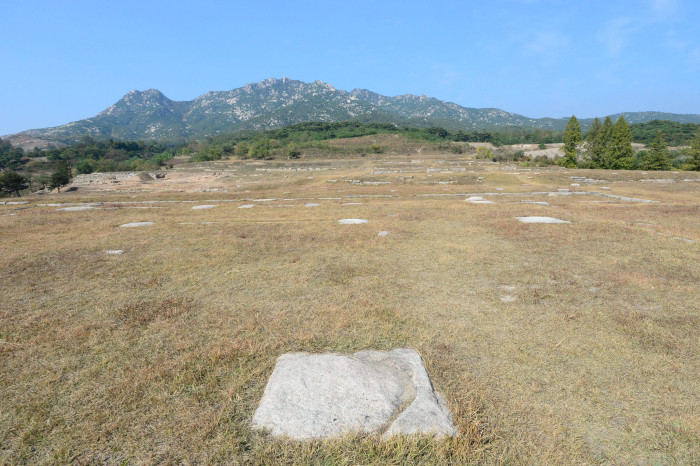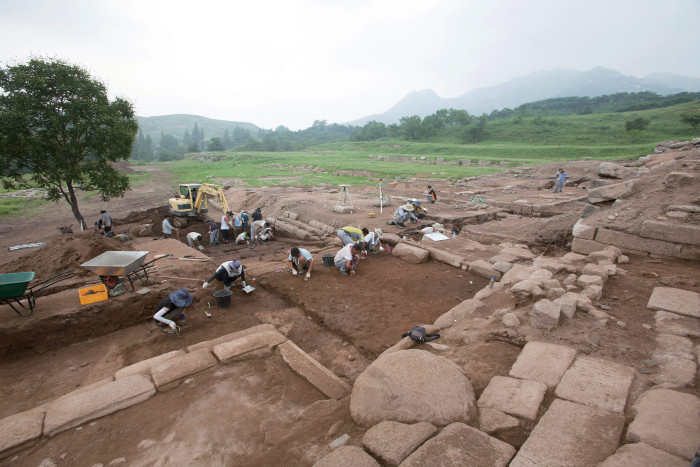GyeongGi Cultural Properties
3. Manwoldae and Seonjukgyo - Why We Should Remember Goryeo’s Relics in Gaeseong
About 80 km from Seoul and beyond the Inter-Korean Transit Office near Dorasan Mountain in Paju-si, a ride of no more than an hour by car, is Gaeseong, a territory of North Korea. Gaeseong was designated as the capital of Goryeo in 919, a year after the nation’s founding, and was the center of Goryeo for more than 440 years, except during the period in which the government moved the capital to Ganghwa (1232-1270). Gaeseong was such a thriving city that people would say that, on a rainy day, you could walk under the eaves from downtown to the Yeseonggang River and the international trade port without getting wet.
A Panorama of Manwoldae in Gaeseong / Provided by Lee Gwang-pyo |
The first remnants of Goryeo among those to be recognized is Manwoldae, the site of Goryeo’s palace and National Treasure No. 122 of North Korea. It is located across an extensive area south of Songaksan Mountain, with the mountain as its background to the north. It is 373 meters in width, 725 meters in depth, and has a circumference of 2,170 meters.
|
At Manwoldae, buildings were constructed after piling up the soil to raise the ground. This was to conserve the natural atmosphere of Songaksan Mountain and to strengthen the authority and dignity of the Goryeo Dynasty. ‘Manwoldae’ was originally the name of the front yard of Hoegyeongjeon Hall, the main hall that was built based on high retaining walls, and the name was later used to refer to the palace as a whole.
Manwoldae, where the king lived, was the most important palace among several others of Goryeo in Gaeseong. It was composed of Hwangseong (where the aristocracy undertook affairs of state) on its border and Gungseong (where the king and queen lived) inside. Gungseong consisted of three sections: Oejeon (outside quarter), with Hoegyeongjeon Hall as its center; Naejeon (inside quarter), with Janghwajeon Hall as its center; and Chimjeon (house of the king's bedroom) on the northwest side.
Manwoldae was partially destroyed and rebuilt after undergoing ordeals like the Khitan invasion during the reign of King Hyeonjong, the Rebellion of Lee Jagyeom during the reign of King Injong, and the Mongol invasion during the reign of King Gojong. In 1361, during the reign of King Gongmin, however, it was completely destroyed due to a major fire during the Red Turban invasions. The current palace site has been maintained since that period. What is most impressive among the ruins of Manwoldae is the grand 33 flights of stairs that lead to Hoegyeongjeon Hall. It feels both lonely and magnificent, showing all of the glory and shame of the 500-year Goryeo Dynasty. The west part of Manwoldae was discovered during the seven joint excavations by North and South Korea from 2007 to 2015.
Seonjukgyo Bridge (National Treasure No.138 of North Korea), which contains a tragic story, should also be mentioned when we talk about the cultural relics of Goryeo. Here, in 1392, when the fate Goryeo was at hand, Poeun Jeong Mong-ju (1337-1392), a faithful subject of the dynasty, was murdered by a faction of Lee Bang-won (later King Taejong of Joseon).
|
Seonjukgyo Bridge was built in 1216, and was originally named ‘Seonjigyo’. It was later called Seonjukgyo because, after the death of Jeong Mong-ju, a bamboo shoot sprouted from the spot, and the name was altered to use the Chinese character 竹 (juk), which means bamboo. It is said that the bloodstain of Jeong Mong-ju still remains on the bridge, and until today, blood tainted rainwater flows under it when it rains. With the name of Seonjukgyo and the story about the bloodstain, we can feel the intent of posterity as they try to remember the sincere heart of the Goryeo loyalist.
A large number of stone and wooden pagodas were constructed in Gaeseong, the capital city of the Buddhist nation. However, most of them vanished over the many years and wars. The only ones that remain are the Five-story Stone Pagoda at Yeongtongsa Temple (National Treasure No.133 of North Korea), the Five-story Stone Pagoda at Burilsa Temple, and the Seven-story Stone Pagoda at Hyeonghwasa Temple, illustrating the beauty of simplicity of Goryeo’s pagoda. The unique Stupa of Buddhist Monk Jigong of Hwajangsa Temple is a masterpiece that embodies the departure in styling of Goryeo’s Buddhist stone art. The Tomb of King Taejo (National Treasure No.179 of North Korea) and the Tomb of King Gongmin (National Treasure No.123 of North Korea, consisting of the Hyeonneung Royal Tomb, where King Gongmin was buried, and the Jeongneung Royal Tomb, where his wife Princess Noguk was buried) are also cultural relics that should be remembered.
North Korea's border city of Gaeseong is a lonely place. The remnants of division can be found everywhere. There is a fact, however, that cannot be changed—that it was once the capital of Goryeo. Those cultural properties from the Goryeo Period have stood for a thousand years to bear witness to that fact. Recently, a plan was unveiled to open a joint liaison office in Gaeseong thanks to the atmosphere of reconciliation between South and North Korea. News has also come out about resuming the joint excavation of Manwoldae. The cultural assets of Goryeo that remain in Gaeseong should become one of the major historical and cultural aspects of Gyeonggi Province in the age of Korean unification. This is why we should turn our gaze to ‘Gaeseong and Goryeo’. / ◎ Lee Gwang-pyo (Editorialist of Dong-A Ilbo)
<Copyright(c)2002 GGC All rights reserved.>

 A Joint Excavation of Manwoldae in Gaeseong / Provided by Lee Gwang-pyo
A Joint Excavation of Manwoldae in Gaeseong / Provided by Lee Gwang-pyo Seonjukgyo Bridge in Gaeseong / Provided by Lee Gwang-pyo
Seonjukgyo Bridge in Gaeseong / Provided by Lee Gwang-pyo